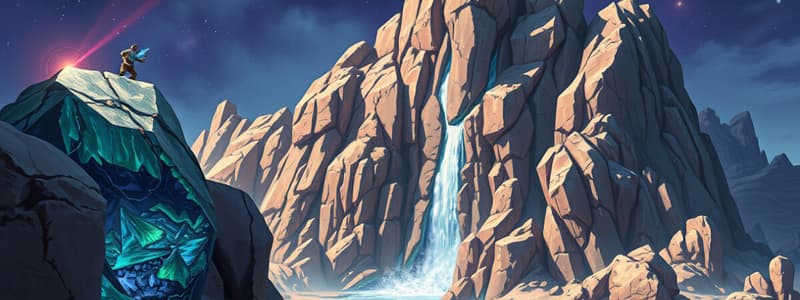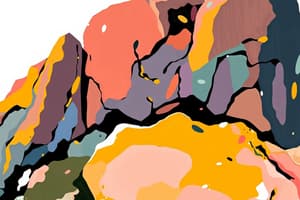Podcast
Questions and Answers
Calcite (CaCO3) is in which mineral class?
Calcite (CaCO3) is in which mineral class?
- Silicates
- Oxides
- Carbonates (correct)
- Sulfides
Pyrite (FeS2) is in which mineral class?
Pyrite (FeS2) is in which mineral class?
- Sulfides (correct)
- Silicates
- Phosphates
- Carbonates
The mineral class that makes up more than 95% of rocks in the continental crust is termed?
The mineral class that makes up more than 95% of rocks in the continental crust is termed?
silicates
Which layer of Earth does NOT contain silicate minerals?
Which layer of Earth does NOT contain silicate minerals?
A __________ is a mineral-lined cavity in a rock.
A __________ is a mineral-lined cavity in a rock.
Minerals that grow around volcanic vents MOST likely form by?
Minerals that grow around volcanic vents MOST likely form by?
The color of a mineral in powdered form is termed?
The color of a mineral in powdered form is termed?
Cleavage in minerals refers to?
Cleavage in minerals refers to?
Synthetically made glass and natural quartz crystals both exhibit a fracture pattern termed?
Synthetically made glass and natural quartz crystals both exhibit a fracture pattern termed?
With regard to minerals, hardness refers to the ability to resist?
With regard to minerals, hardness refers to the ability to resist?
Geologists refer to an exposure of bedrock on the surface as a(n)?
Geologists refer to an exposure of bedrock on the surface as a(n)?
Diamonds are found in?
Diamonds are found in?
A facet is a __________ on a gem.
A facet is a __________ on a gem.
What type of rock forms by the solidification of a melt?
What type of rock forms by the solidification of a melt?
What type of rock forms when preexisting rocks undergo changes in response to a modification of their environment, without first melting?
What type of rock forms when preexisting rocks undergo changes in response to a modification of their environment, without first melting?
The difference between magma and lava is that __________.
The difference between magma and lava is that __________.
Which type of magma has the greatest silica content?
Which type of magma has the greatest silica content?
Viscosity controls how __________.
Viscosity controls how __________.
The mantle is composed entirely of __________.
The mantle is composed entirely of __________.
In general, if a body of igneous (source) rock is subjected to partial melting, the magma that is produced is expected to be __________.
In general, if a body of igneous (source) rock is subjected to partial melting, the magma that is produced is expected to be __________.
An irregular-shaped and bloblike igneous rock body that cooled beneath the surface of Earth is a __________.
An irregular-shaped and bloblike igneous rock body that cooled beneath the surface of Earth is a __________.
A sill is a(n) __________.
A sill is a(n) __________.
A batholith is a(n) __________.
A batholith is a(n) __________.
Magma tends to __________.
Magma tends to __________.
Columnar jointing forms primarily because of?
Columnar jointing forms primarily because of?
The extremely high __________ within Earth prevents rock from melting.
The extremely high __________ within Earth prevents rock from melting.
All other factors being equal (i.e., depth, volume, temperature, etc.), which type of igneous intrusion would cool fastest?
All other factors being equal (i.e., depth, volume, temperature, etc.), which type of igneous intrusion would cool fastest?
Ash, and larger fragments of pumice are all examples of?
Ash, and larger fragments of pumice are all examples of?
Felsic igneous rocks typically?
Felsic igneous rocks typically?
Bubbles trapped in lava after the molten material are cooled are called?
Bubbles trapped in lava after the molten material are cooled are called?
Compared with coarse-grained igneous rocks, fine-grained igneous rocks?
Compared with coarse-grained igneous rocks, fine-grained igneous rocks?
Granite, a coarse-grained, felsic intrusive igneous rock is most similar in mineral composition to __________, which is a fine-grained, felsic extrusive equivalent.
Granite, a coarse-grained, felsic intrusive igneous rock is most similar in mineral composition to __________, which is a fine-grained, felsic extrusive equivalent.
Why is the outer core the only layer in Earth that is molten?
Why is the outer core the only layer in Earth that is molten?
Compared with mafic igneous rocks, all felsic igneous rocks?
Compared with mafic igneous rocks, all felsic igneous rocks?
Volcanic arcs form along __________ boundaries.
Volcanic arcs form along __________ boundaries.
Which type of volcano forms from layers of mafic lava erupted in primarily effusive eruptions?
Which type of volcano forms from layers of mafic lava erupted in primarily effusive eruptions?
__________ form from piles of pyroclastic debris (mainly lapilli) that fountain out of a vent during an effusive eruption.
__________ form from piles of pyroclastic debris (mainly lapilli) that fountain out of a vent during an effusive eruption.
Flashcards are hidden until you start studying
Study Notes
Mineral Classes
- Calcite (CaCO3) belongs to the Carbonates class.
- Pyrite (FeS2) is categorized under Sulfides.
- The mineral class constituting over 95% of rocks in the continental crust is known as silicates.
- The outer core does not contain silicate minerals.
Mineral Characteristics
- A geode is a mineral-lined cavity formed in a rock.
- Volcanic vent minerals predominantly form through precipitation from gas.
- The streak of a mineral refers to its color in powdered form.
- Cleavage describes a mineral's tendency to break along planes of weakness.
- Conchoidal fracture is exhibited by both synthetically made glass and natural quartz crystals.
- Hardness assesses a mineral's ability to resist scratching.
Geological Features
- Exposure of bedrock at the surface is termed an outcrop.
- Diamonds are found in kimberlite formations.
- A facet is a polished surface on a gem.
Rock Types and Formation
- Igneous rocks form from the solidification of molten material.
- Metamorphic rocks arise from changes in preexisting rocks without melting.
- Magma is located beneath the surface, whereas lava is above it.
- Felsic magma contains the highest silica content.
Viscosity and Rock Composition
- Viscosity determines the speed at which a fluid flows.
- The mantle consists entirely of ultramafic rock.
- Partial melting of igneous rock produces magma that is typically more felsic than the original rock.
Types of Igneous Intrusions
- A pluton is an irregular, blob-shaped igneous rock body found beneath Earth's surface.
- A sill is a tabular intrusion that runs parallel to surrounding sedimentary rock layers.
- A batholith is a large, compound igneous intrusion.
- Magma tends to move upward, away from its formation location.
Cooling Processes and Textures
- Columnar jointing results from contraction and cracking during the cooling of rock.
- High pressure within Earth prevents rock melting.
- Among igneous intrusions, dikes cool fastest under equal conditions.
- Pyroclastic debris includes ash and larger fragments of pumice.
Rock Color and Texture
- Felsic igneous rocks are generally lighter in color than mafic rocks.
- Vesicles are bubbles trapped in lava after cooling.
- Compared to coarse-grained igneous rocks, fine-grained igneous rocks cool and solidify more quickly.
- Granite, a coarse-grained felsic intrusive rock, is similar in mineral composition to rhyolite, a fine-grained felsic extrusive rock.
Earth's Layers and Volcanism
- The outer core is uniquely molten due to high temperatures and relatively low pressure sufficient to melt iron.
- All felsic igneous rocks solidify at lower temperatures than mafic rocks.
- Volcanic arcs are located along convergent boundaries.
- Shield volcanoes form from layers of mafic lava through primarily effusive eruptions.
- Cinder cones are formed from piles of pyroclastic debris, mainly lapilli, erupted during effusive events.
Studying That Suits You
Use AI to generate personalized quizzes and flashcards to suit your learning preferences.




